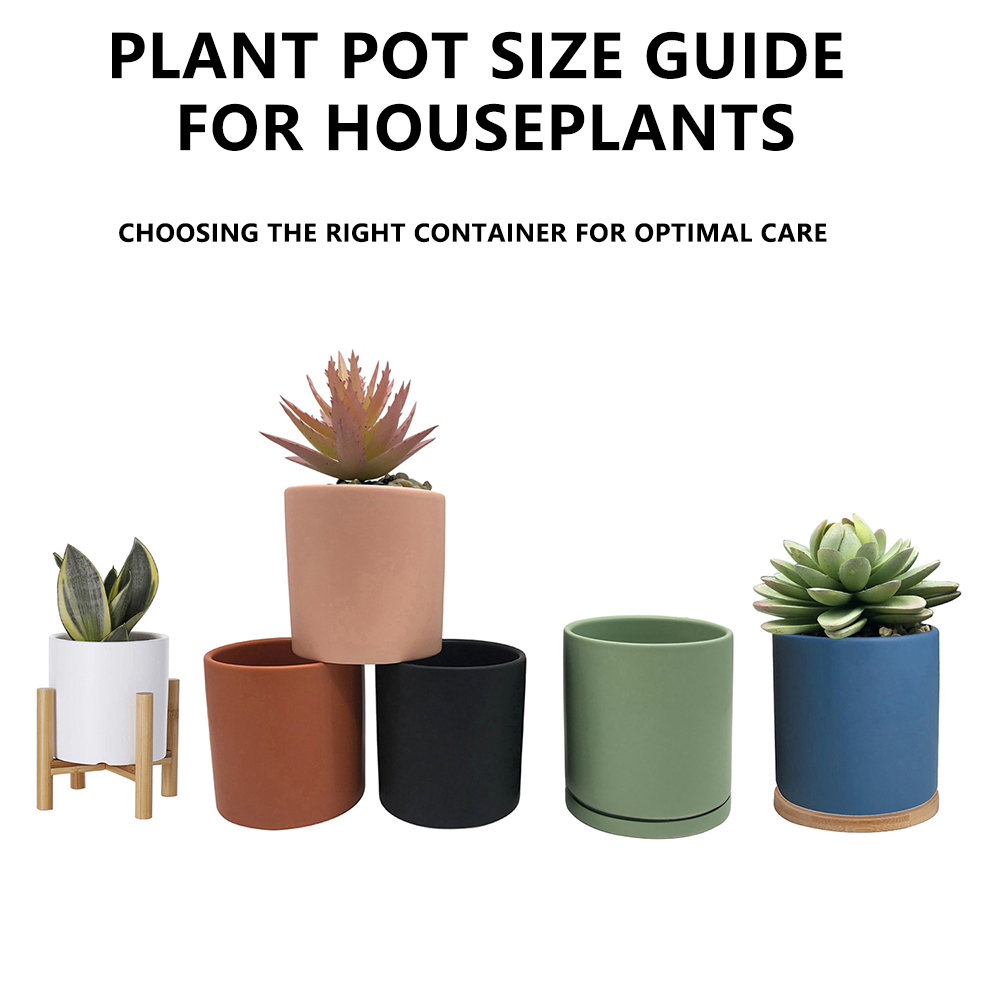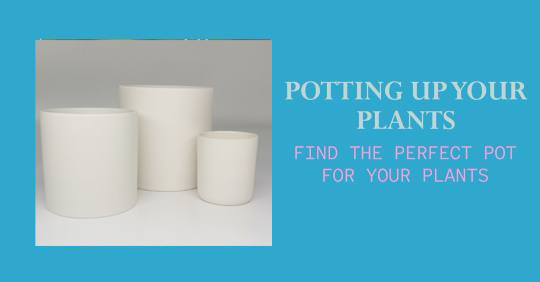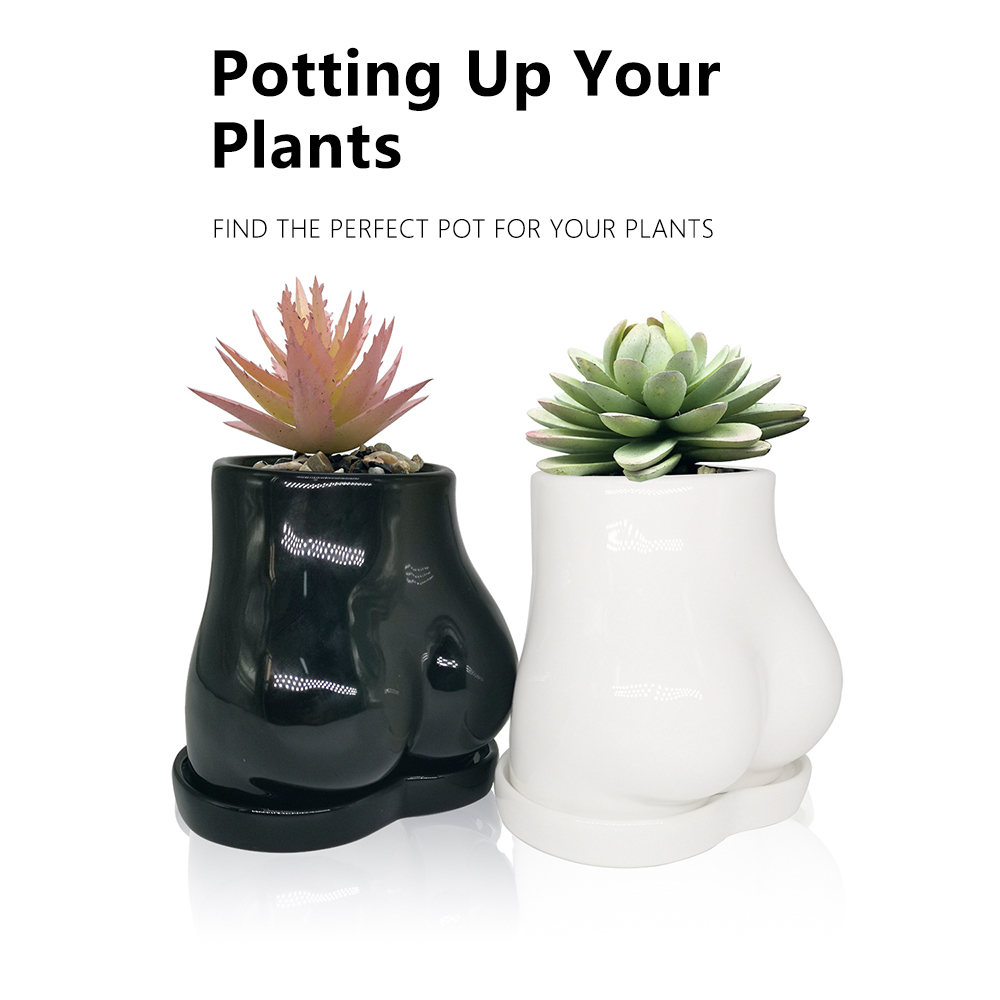Guida alle dimensioni dei vasi per piante da interno: Global Reach Ceramic
Ora di emissione: 2024-04-29 09:54:12
Scegliere un vaso della dimensione giusta è fondamentale per la salute e lo sviluppo delle piante. Considerate le dimensioni attuali e previste della pianta prima di prendere una decisione definitiva sul contenitore.
La salute e la felicità delle tue piante dipendono direttamente dalle dimensioni dei contenitori che utilizzi. Puoi evitare problemi come l'aggrovigliamento delle radici e dare loro spazio per espandersi scegliendo la dimensione giusta. Per evitare ristagni d'acqua e garantire un drenaggio adeguato, è importante scegliere il contenitore della dimensione giusta. In questo modo, puoi essere certo che le tue piante ricevano le cure ottimali.
Se vuoi che le tue piante d'appartamento o da esterno siano belle e prosperino a lungo, devi assicurarti di acquistare un vaso della giusta dimensione. Quando scegli la dimensione perfetta del vaso per le tue amiche verdi, tieni presente sia le loro dimensioni attuali che la velocità di crescita.
Importanza delle dimensioni dei vasi
Se vuoi che le tue piante prosperino, devi assicurarti di poter fornire loro i contenitori appropriati. Per il benessere dei tuoi compagni verdi, la dimensione del vaso è di fondamentale importanza. Assicurarti che il vaso sia della dimensione giusta influisce sul drenaggio e sull'apparato radicale, che a sua volta influisce sul vigore e sulla durata delle piante. Innanzitutto, parliamo dell'importanza di scegliere un contenitore della dimensione giusta per le tue piante.
Scegliere la taglia giusta per una crescita sana
Quando si sceglie un contenitore per le piante, è fondamentale assicurarsi che le radici abbiano spazio a sufficienza per crescere. Esiste una correlazione tra le dimensioni del contenitore e la salute e lo sviluppo generale dell'apparato radicale. Uno spazio insufficiente può portare alla costrizione delle radici e a un ridotto assorbimento dei nutrienti, entrambi indicatori di una crescita stentata dovuta alla mancanza di spazio.
Impatto sul drenaggio e sui sistemi radicali
Le proporzioni del sistema di drenaggio sono direttamente proporzionali alle dimensioni del contenitore. È possibile che una pianta marcisca le radici se viene collocata in un contenitore troppo grande per le sue esigenze. Questo può essere causato dalla presenza di terreno umido. D'altra parte, le radici potrebbero potenzialmente soffocare se si lascia che l'acqua si accumuli in un vaso piccolo e privo di fori di drenaggio.
Tipi di vasi per piante

Nella scelta della dimensione giusta del vaso , è fondamentale considerare le numerose varianti di contenitori per piante disponibili oggi sul mercato. Conoscendo le caratteristiche che un contenitore dovrebbe avere, sarà possibile scegliere il contenitore ideale per le proprie piante.
Let's have a look at the different types of plant containers, the materials that are typically used, and the factors that are important to keep in mind for each.
Common Materials Used
Plant pots are available in various materials, each with its own advantages and considerations. The common materials used for plant pots include:
- Terracotta: Known for its porous nature, which allows air and moisture to pass through the pot. It's suitable for plants that prefer drier soil.
- Plastic: Lightweight and affordable, plastic pots are easy to transport and come in a wide range of sizes and colors.
- Ceramic: These pots are durable and retain moisture well, making them suitable for plants that require consistent watering.
- Wood: Offers a natural, rustic look and can provide insulation to plant roots. However, they may deteriorate over time and require maintenance.
- Metal: Often used for decorative purposes, metal pots can conduct heat, so they are best for plants that don't mind warmer soil.
Considerations For Different Plant Types
When selecting plant pots, it's important to consider the specific needs of different plant types. Here are some key considerations for various plant categories:
| Plant Type | Considerations for Plant Pot Sizing |
| Flowering Plants | Opt for larger pots to accommodate extensive root systems and promote healthy growth and blooming. |
| Succulents and Cacti | Choose well-draining pots to prevent waterlogging and ensure proper soil aeration. |
| Herbs | Consider smaller, shallow pots with good drainage for herbs with shallow root systems. |
| Vegetables | Select larger pots to provide ample space for root development and ensure adequate nutrient uptake. |
How To Measure Plant Pots
How to measure plant pots: Measuring plant pots accurately is essential for the health and growth of your plants. It ensures they have the right space for their roots and sufficient drainage. Understanding the proper sizing can help prevent issues such as root rot and over-watering.
Matching Pot Size To Plant Size
Consider the size of the plant's root system when choosing a pot. Aim to select a pot that is 2 inches larger in diameter to allow room for growth. Overly small pots can restrict root development and cause stunted growth.
Understanding Drainage Needs
Proper drainage is crucial for plant health. Make sure pots have drainage holes to prevent waterlogging. Use a saucer underneath to catch excess water and avoid root rot.
Effects Of Improper Sizing
Improper plant pot sizing can hinder plant growth, leading to root-bound roots and water stagnation. Inadequate sizing limits airflow, causes water accumulation, and restrains plant development. Choose pots that fit the plant size to ensure healthy growth.
Root Bound Plants
One of the most common effects of improper sizing when it comes to plant pots is root binding. When a plant outgrows its pot and its roots become too crowded, they start to circle within the pot, unable to spread out and grow freely. This can lead to various issues for the plant's overall health and growth.
Root bound plants may experience stunted growth and reduced nutrient absorption, as their tightly packed roots struggle to take in water and nutrients efficiently. This can result in weaker plants that are more susceptible to disease and pests.
Additionally, root bound plants may have difficulty accessing oxygen, as the tightly packed roots limit airflow. Lack of oxygen can hinder root development and impair the plant's ability to take up water and nutrients from the soil.
To determine if a plant is root bound, you can carefully remove it from its pot and examine the root system. If the roots appear tightly packed, circling around the pot, or growing out of the drainage holes, it's a clear indication that the plant needs to be repotted into a larger container.
Waterlogging Issues
Another consequence of improper pot sizing is waterlogging, which occurs when excess water accumulates at the bottom of the pot with no way to drain properly. This can be detrimental to plant health as it leads to oxygen deprivation and root rot.
When a pot is too large for the plant, excess soil holds onto water, preventing it from evaporating or draining away effectively. The soil becomes waterlogged, causing the roots to suffocate and eventually rot. This can result in root decay, plant wilting, and overall decline.
Waterlogged plants are more susceptible to fungal and bacterial infections, as the excess moisture creates a favorable environment for these pathogens to thrive. The lack of oxygen in waterlogged soil further weakens the plant, making it more susceptible to disease and pest infestation.
To prevent waterlogging, it's crucial to choose a pot that matches the size of the plant, allowing for proper drainage and airflow. Proper drainage holes in the pot are also essential to facilitate the movement of excess water out of the container.
Repotting Strategies
Repotting is essential for the health of your plants. Know Signs It's Time to Repot and master Proper Repotting Techniques.
Signs It's Time To Repot
- Roots emerging from drainage holes
- Stagnant growth or yellowing leaves
- Pot becoming root-bound
- Soil drying out quickly or retaining too much water
Proper Repotting Techniques
- Choose a pot 1-2 sizes larger than current one
- Gently loosen root ball and trim any rotting roots
- Add fresh potting mix to new pot
- Place plant in center, fill gaps with soil
- Water thoroughly and place in adequate sunlight
Creative Plant Pot Ideas
Liven up your space with these Creative Plant Pot Ideas! When it comes to adding some freshness to your home or garden, plant pots are a simple and effective way to do so. While traditional ceramic or plastic containers are commonly used, there is a world of unconventional containers waiting to be utilized. From repurposed household items to unique DIY projects, you can give your plants a stylish and unique home. In this article, we will explore some innovative ideas to transform your plant pots and breathe new life into your botanical collection.
Utilizing Unconventional Containers
Think outside the box with these unconventional container ideas:
- Repurpose vintage tin cans as plant pots for a retro touch to your decor.
- Transform old wooden crates into rustic plant holders for a farmhouse-inspired look.
- Bring nature indoors by using hollowed-out tree stumps or logs as natural planters.
- Create a whimsical atmosphere by repurposing teapots or vintage suitcases as unique plant pots.
By utilizing unconventional containers, you can add a touch of personality and charm to your plant display, making it a conversation starter in any gathering.
Diy Potting Projects
Get your creative juices flowing with these exciting DIY potting projects:
- Painted Terracotta Pots: Add a pop of color to your outdoor space by painting plain terracotta pots with vibrant geometric patterns or floral designs.
- Mosaic Plant Pots: Give your plants a mosaic makeover by adhering colorful glass tiles or broken ceramic pieces onto plain pots for a dazzling effect.
- Macrame Plant Hangers: Craft your own macrame plant hangers using ropes or yarns, customizing the length and design to suit your space.
- Vertical Wall Planters: Utilize your vertical space by constructing a wall-mounted planter using recycled pallets or wooden planks, perfect for small gardens or apartment balconies.
With these fantastic DIY potting projects, you can showcase your artistic flair while giving your plants a unique and personalized home.
Maintenance Tips For Plant Pots

Maintenance Tips for Plant Pots Plant pot maintenance is essential for the health and vitality of your plants.
Here are some steps to clean and sterilize your plant pots:
1. Remove any remaining soil from the pot.
2. Wash the pots with a mild soap and water solution.
3. Sterilize the pots by soaking them in a 1:10 bleach and water solution for 10 minutes.
4. Rinse the pots thoroughly with clean water and allow them to air dry before reusing. Seasonal Care Recommendations It is important to adjust your plant pot care according to the changing seasons.
Choosing The Right Potting Mix
Quando si tratta di scegliere le dimensioni del vaso, la scelta del terriccio giusto è fondamentale per la salute e il successo delle piante. Il terriccio fornisce nutrienti essenziali, aerazione e ritenzione idrica, creando un ambiente ottimale per la crescita. Conoscere i componenti dei diversi terricci e abbinarli alle esigenze specifiche delle piante è essenziale per garantire piante sane e rigogliose.
Comprendere i diversi componenti del mix
Prima di scegliere un terriccio per invasatura, è importante comprenderne i vari componenti comunemente presenti. Diversi mix possono contenere una combinazione di torba, perlite, vermiculite, compost e altri materiali organici. La torba, ingrediente principale, garantisce la ritenzione idrica e l'aerazione, mentre perlite e vermiculite contribuiscono al drenaggio e alla circolazione dell'aria. Il compost arricchisce il terriccio di nutrienti, favorendo la crescita delle piante.
Abbinamento del mix alle esigenze delle piante
Ogni pianta ha esigenze specifiche in termini di umidità, livelli di nutrienti e aerazione. È fondamentale adattare il terriccio a queste esigenze per garantire una crescita ottimale. Ad esempio, le piante grasse e i cactus prosperano in terreni sabbiosi ben drenati, mentre le piante tropicali potrebbero richiedere un terriccio più ricco, che trattenga l'umidità e abbia un contenuto organico più elevato. Comprendere le esigenze specifiche della tua pianta ti guiderà nella scelta del terriccio più adatto.
Parola finale
Scegliere il vaso della giusta dimensione è fondamentale per la salute e la crescita della tua pianta. Ricorda di considerare il drenaggio, lo spazio per le radici e la crescita futura. Con questi consigli, puoi garantire che la tua pianta prosperi nella sua nuova casa.
Buon giardinaggio e che il tuo pollice verde prosperi!
Domande frequenti
Domanda: come faccio a sapere che dimensione di vaso devo prendere per la mia pianta?
Risposta: Scegli un vaso con un diametro di 2,5-5 cm più grande di quello attuale. Assicurati che abbia fori di drenaggio e considera il tasso di crescita della pianta. Un vaso con spazio sufficiente per le radici favorisce una crescita sana.
Domanda: il vaso dovrebbe essere più grande della pianta?
Risposta: Sì, il vaso dovrebbe essere leggermente più grande della pianta per consentirne la crescita e il corretto sviluppo delle radici.
Domanda: qual è il rapporto tra l'altezza della pianta e la dimensione del vaso?
Risposta: Il rapporto tra altezza della pianta e dimensioni del vaso varia a seconda della specie. Generalmente, il vaso dovrebbe essere alto circa un terzo della pianta. Adattare le dimensioni del vaso alle esigenze di crescita della pianta è fondamentale per uno sviluppo sano e un adeguato supporto dell'apparato radicale.
Domanda: quanto spazio necessita una pianta in un vaso?
Risposta: una pianta ha bisogno di spazio sufficiente in un vaso affinché le sue radici possano crescere e diffondersi. Il vaso dovrebbe essere abbastanza grande da ospitare comodamente l'apparato radicale.
POST RECENTI
- I vantaggi dei prodotti ceramici all ingrosso di alta qualità per i rivenditori
2025-12-17
- Puoi realizzare un posacenere con argilla essiccata all aria
2025-12-17
- L'impatto dei materiali ceramici negli edifici ad alta efficienza energetica
2025-12-04
- I 7 principali benefici per la salute delle pentole in ceramica
2025-12-04
- Come pulire i vasi in ceramica e prolungarne la durata?
2025-11-17
- Le 15 migliori idee regalo in ceramica per le feste del 2025: premurose, eleganti e sentite
2025-11-17
- Gres vs Porcellana vs Terracotta: Guida Rapida alla Decisione
2025-10-09
- Gli smalti ceramici sono sicuri per gli alimenti? La verità dietro la lucentezza
2025-10-09
Hai bisogno di un preventivo?Hai domande?
Ricevi una risposta da un esperto entro 24 ore
PARLA CON UNO SPECIALISTA >









